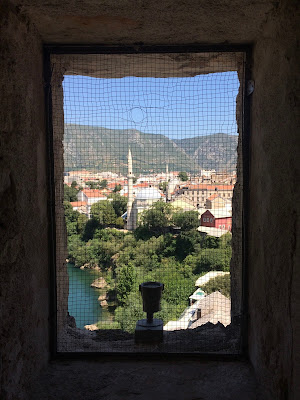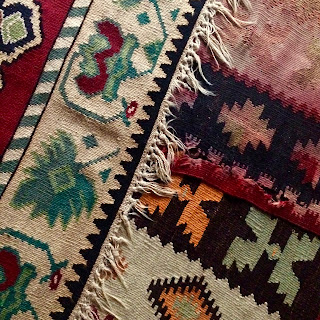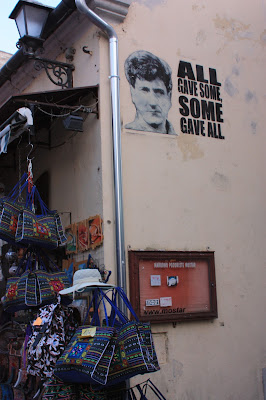I spent most of my time in Bosnia and Herzegovina in a kind of giddy delirium.
I was so happy from the moment I stepped off the bus from Split, Croatia and into the astounding heat of Mostar. Giddy, sweaty, and exhausted. I'm not proud to say that my first act in Bosnia was a nap. But once I was a little more rested, I headed out to enjoy twilight in the lovely little Old Town. The streets are paved with slippery, worn stones, meaning I had to watch every step and was still always on the verge of falling down. This was the first time I heard the call to prayer as it rang out through the city, punctuating the comical soundtrack of my walk; INXS, Cindy Lauper, ACDC, along with scattered local songs played in all the restaurants. After my walk, I stopped for dinner and met my first local; as the owner of a little restaurant on the way out of town took my order (more like I took his recommendation), he asked where I was coming from. When I told him, he launched into perfect Italian, having lived in Tuscany for 4 years, along with having spent years in Portugal and Germany as well. Though I am constantly surrounded by bilingual or trilingual children, meeting multilingual people will never cease to impress me!
Mostar's main tourist attraction is the Stari Most, a large bridge built in the 15th century that crosses the Neretva River.

Sadly, most of the Old Town and the bridge were destroyed during the war in the early 1990s. Since then, Bosnia has worked to restore the city and preserve what they could of their history. The area surrounding the bridge is a true example of cultures coming together; "pre-Ottoman, eastern Ottoman, Mediterranean, and western European architectural features" (according to UNESCO) comprise the area, and is "a symbol of reconciliation, international co-operation, and of the coexistence of diverse cultural, ethnic and religious communities." From the bridge, the view is lovely; deep green and aquamarine water rushes below, and you can tell just from looking that it must be freezing. To one side, the dome and tower of a mosque protrude towards the water, and I knew right away that I had to find it before it closed.
 Mostar is so small that it didn't take much time for me to find the mosque I'd spotted.
Mostar is so small that it didn't take much time for me to find the mosque I'd spotted.
Dressed in a tank top and shorts, I removed a sweater from my bag and asked the woman selling tickets if this would be modest enough or if I should come back tomorrow. Surprisingly, she didn't even glance my way before telling me I didn't need it but could use a scarf to cover my legs if I wanted to. I did, but am sorry to say that it didn't last long. I've climbed the towers of Notre Dame and the Sagrada Familia, as well as Milan's Duomo, and while the 88 steps to the top of the mosque's minaret had nothing on those cathedrals' steps in terms of number, I have never been more claustrophobic in my life. That said, the view was worth the stair-terror. The sun was setting as I reached the top, casting the most perfect golden light on the bridge, city, and surrounding countryside. Once the only other guest left I had some time to myself at the top to just surrender to the peace and joy I felt looking out. My peace was short-lived, however, once I realized I had to get back down to the ground somehow. Oh my gosh, the spiral of the staircase is so tight and steep that I'm not joking, I actually crawled back down the stairs (obviously, scarf removed from my legs).
 On my second day, I was literally a woman in love;
On my second day, I was literally a woman in love;
in love with travel, with new opportunities, with history, with independence... I didn't want to let one second go to waste or to miss one moment (except during my daily nap- hey, it was really 100 degrees most days, a nap was necessary). Because the town is so small, there options aren't overwhelming, so I walked into every single museum I passed. The Hamam Museum was a small and didn't take long to go through, but provided a glimpse into the bath-house ritual that is so prevalent in the Ottoman Empire, and I was lucky enough to experience in Morocco. The Old Bridge Museum was a much longer event. I was up and about early that morning, and was the first visitor to the old tower. When I arrived, the man selling tickets was sweating bullets, having just climbed the five-story, fifteenth century tower, I assume to turn on all the lights. As he struggled to catch his breath, we made small talk about the city, and he asked if I had a student ID. I didn't and told him I was a teacher, not a student. He informed me that he had been a history teacher, which of course led to a conversation about Mostar's troubled history and A 45 MINUTE LECTURE on the various religious influences and occupations Mostar has seen in the last 500 years. While it was interesting at first, there wasn't no opportunity to interject, and I thought it might never end. Luckily (though I really mean it, it was very interesting) a couple came through and needed directions getting to the second tower and I was able to rush up the stairs and through the museum.
 As I mentioned, Mostar has preserved its history as well as it can, with the Old Bridge area of the city on UNESCO's list of World Heritage Sites.
As I mentioned, Mostar has preserved its history as well as it can, with the Old Bridge area of the city on UNESCO's list of World Heritage Sites.
The Muslibegovic House was next on my list of places to see. I love to see how people once lived, and the Muslibegovic family's home is like a snapshot in the life of a (wealthy) 18th century family. You can actually stay in a few of the rooms of the house, and I was thisclose to canceling my reservation at Hotel Kapetanovina to book myself a few nights there when I realized the one night there cost more than three at my current hotel (and I'm very glad I didn't cancel because I absolutely loved my hotel; more in another post). There are various displays throughout the home, including clothing and household objects, preserved texts, and a little meal scene with dressed-up mannequins (I think they told me that men and women would really have eaten separately, but I may be wrong; I heard a lot of things that day). Carefully woven rugs overlapped across the floor with contrasting patterns, and each room was lit only through the many windows that lined each wall. One room I found particularly intriguing was a nursery on the second floor where the mother was basically banished to for a while after a baby was born (well, maybe not banished, maybe it was more of a haven than a dungeon...).

At one point that day I found myself on a quiet road right behind the busy Old Town.
I passed a stunning cemetery full of pure white headstones, each surrounded with vases of colorful flowers. They were so lovely that I stopped to walk through, which is not something I can say I typically do with a cemetery (excluding Milan's). The first one I read shocked me, as the man it honored would have been only twenty years old when he died. As I continued to look, now openly crying, I realized that nearly all of the stones were etched with the same year: 1993. Some were as young as 17. I don't want to get to much into the war in this post, but Mostar was heavily attacked in 1993, and the evidence remains visible throughout the city. The cemetery wasn't the only remnant of Mostar's violent past. Shells of roofless buildings taken over by weeds and graffiti stand between shops and restaurants immediately outside the quaint Old Town, peppered with bullet holes.
I went back to the hotel after that, drained from the sadness of the cemetery as well as the heat.
I had visited every site I could think of, wandered for hours, and needed a rest. Above I mentioned loving my hotel; when I walked in on the first day, the manager greeted me by name as he held the door for me to pull my bags through. That was just the first surprising moment of hospitality I experienced in the next few days. I headed down to the front desk after my rest that day for some advice. It was approaching closing time, and I needed a little advice about which old house to visit. When I showed the woman behind the desk my two options, she gave me a strange look and told me that the home of the 16th century Turkish judge that I was interested in seeing was actually where she grew up. It's a museum, a preserved monument, and she lived there. Whattttttt? Anyway, she suspected it would be closed but called her mom to give her a heads up that I was on my way.
The Kajtaz House isn't easy to find; it's surrounded by tall walls, hidden away on a pedestrian street.
 When I finally found it, I rang the bell twice before a sweet older woman who didn't speak a word of English came to the door. She let me in and walked me through the courtyard, speaking maybe Bosnian the whole time. A man was repairing concrete in a small living room, and she handed him a paper with what I'm assuming was a message from her daughter asking him to let me in. He stopped his work in a disgruntled manner, and asked me if I wanted any information or just to walk through. I told him I didn't want to bother him, I was fine to just look through and could read up on it later. Absolutely not, he responded that I'd be much happier if I knew what I was seeing, and proceeded to give me a little of the house's background. He pointed out the different parts of the home that were designated for men or women, and proudly brought up that his family's home was protected by UNESCO. I left him to get back to his work, and admired the richly decorated rooms, artifacts, and especially all of the gorgeous textiles. When I finished, he stopped his work again to entertain me with stories from growing up behind the walls, and about how much he loves the privacy that provides.
When I finally found it, I rang the bell twice before a sweet older woman who didn't speak a word of English came to the door. She let me in and walked me through the courtyard, speaking maybe Bosnian the whole time. A man was repairing concrete in a small living room, and she handed him a paper with what I'm assuming was a message from her daughter asking him to let me in. He stopped his work in a disgruntled manner, and asked me if I wanted any information or just to walk through. I told him I didn't want to bother him, I was fine to just look through and could read up on it later. Absolutely not, he responded that I'd be much happier if I knew what I was seeing, and proceeded to give me a little of the house's background. He pointed out the different parts of the home that were designated for men or women, and proudly brought up that his family's home was protected by UNESCO. I left him to get back to his work, and admired the richly decorated rooms, artifacts, and especially all of the gorgeous textiles. When I finished, he stopped his work again to entertain me with stories from growing up behind the walls, and about how much he loves the privacy that provides.  So much of what made my stay in Mostar wonderful were the people I talked to. As a community they had been through so much sorrow and tragedy, but were warm and welcoming, always willing to stop and talk with strangers. Though the Kajtaz House was closed, I was given nearly an hour of conversation in addition to my brief solo-tour. Each time I passed the restaurant from the first night, the proprietor would call out, "the Milan teacher!" and ask me about what I'd been up to that day. In only a few days, I felt settled and like a part of the little city.
So much of what made my stay in Mostar wonderful were the people I talked to. As a community they had been through so much sorrow and tragedy, but were warm and welcoming, always willing to stop and talk with strangers. Though the Kajtaz House was closed, I was given nearly an hour of conversation in addition to my brief solo-tour. Each time I passed the restaurant from the first night, the proprietor would call out, "the Milan teacher!" and ask me about what I'd been up to that day. In only a few days, I felt settled and like a part of the little city.




































No comments:
Post a Comment